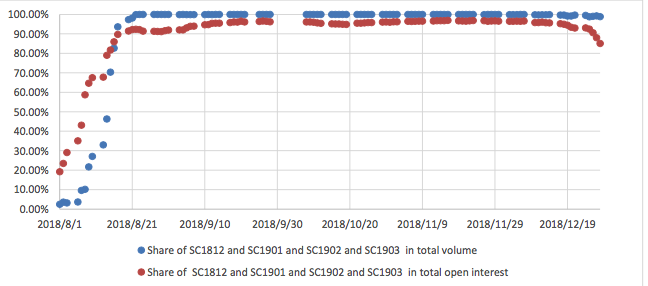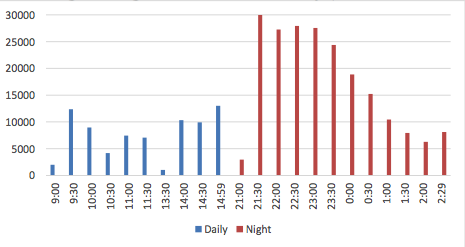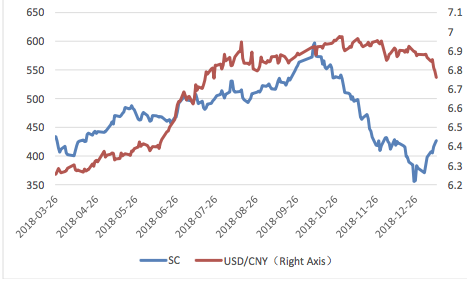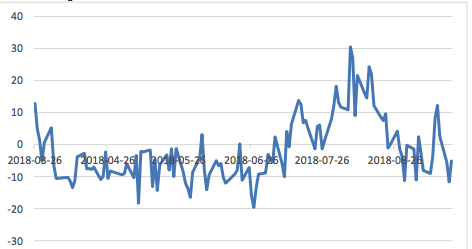Part A: Review (2019/1/7-2019/1/11)
From January 7, 2019 to January 11, 2019:the closing price of the main contract of crude oil futures of INE on Friday was 426.9 yuan/barrel, 28.9 yuan higher than the closing price of the last trading day of last week. The highest price for this week is 428.9 yuan/barrel, and the lowest point is 398.9 yuan/barrel.
This week (2019/1/7-2019/1/11), the total volume of the main contract was 3,007,162 lots, an increase of 1,577,346 lots from last week. After the close of trading this Friday, the open interest of the main contract was 48,972 lots, an increase of 2,786 lots from the last trading day of last week.
Notes: The main contract refers to the futures contract with the maximum open interest.
Part B: Market Dynamics
1. PetroChina plans VLCC berth, crude pipelines at Yantai
China's biggest energy firm state-controlled PetroChina is planning to build new crude berths and other infrastructure at Yantai port in Shandong to help meet rising demand from local independent refineries.
PetroChina's fuel oil unit and local government-owned Yantai Port agreed yesterday to jointly invest around 5bn yuan ($735mn) to build three berths, a second Yantai-Zibo crude pipeline and associated storage tanks.
Yantai Port has been planning to add new infrastructure for some time, but PetroChina's involvement is likely to help achieve its target of completing construction by the end of 2020. The port has been seeking approval to add three crude berths — one capable of receiving 2mn bl very large crude carriers (VLCCs) and two that can receive 1.1mn bl capacity vessels.
The port operator also has started seeking approvals to add a second crude pipeline, which would be able to deliver 400,000 b/d of imported crude from the port to independent refineries. This would comprise a trunk line running parallel to the operational 300,000 b/d Yantai-Zibo pipeline, as well as a pipeline leg connecting Longkou port to the network.
Yantai Port was granted an environmental permit in June 2018 to add 6.6mn bl of crude storage capacity.
State-owned CNOOC operates Yantai's existing VLCC berth and the 300,000 b/d Yantai- Zibo crude pipeline through two joint-venture companies with Yantai Port. The port currently has crude storage tanks with 17mn bl of capacity.
PetroChina has been increasing its investment in crude facilities at Shandong's main ports as it looks to expand its crude trading business to local independent refineries. The company last month started work on 3.77mn bl of storage tanks at Qingdao's Dongjiakou port in a venture with Qingdao Port International.
Part C: Transaction Summary
Since 2018/3/26 and up to 2019/1/11 closing, Shanghai crude oil futures’ cumulative trading volumes is 57. 52 million lots, and the cumulative trading volumes of the first month of listing (2018/3/26-2018/4/25) is 1.33 million lots. The cumulative amount of transaction is 27.31 trillion yuan (2018/3/26-2019/1/11), which is 48.15 times that of the cumulative amount of the first month of listing.
Average daily turnover of the main contract is 601,432 lots (2019/1/2-2019/1/11), and average daily turnover of the main contract is 476,605 lots (2019/1/2-2019/1/4). Open interest of all the contracts of crude oil futures of INE also rised steadily, with 3,558 lots on 2018/3/26 and 71,380 lots after the closing of 2019/1/11.
Graph: Sum of All INE Crude Oil Future contracts (2018/3/26-2019/1/11)

|
Graph: Volume (2018/12/3-2019/1/11) |
Graph: Open Interest (2018/12/3-2019/1/11) |
 |
 |
Graph: SC1812 and SC1901 and SC1902 and SC1903 contracts account for the most share of trading volume and open interest (2018/8/1-2019/1/11)

Graph: Average trading distribution over the day (2018/3/26-2019/1/11)

Graph: Daily Fluctuation Range (2018/3/26-2019/1/11)

Compared with the intra day high and low volatility of three major crude oil futures, the amplitude of Chinese crude oil futures in most of the time is lower than Brent and WTI, indicating that Chinese crude oil futures did not have excessive fluctuations in the day because of the significant speculative ratio and the short time of the market.
Graph: Volume (SC.INE and CL.NYM)

Graph: Volume (SC.INE and B.IPE)

As can be seen from the above graph, since August 2018, the volume of SC.INE has exceeded the volume of B.IPE.
Part D: Correlation analysis
Graph :Price of 3 crude oil futures(in CNY,2018/3/26-2019/1/11)

Table:Correlation of three crude oil futures (2018/3/26-2019/1/11)
|
|
SC | Brent | WTI |
| SC | 1 |
|
|
| Brent | 0.941014 | 1 |
|
| WTI | 0.84265 | 0.929077 | 1 |
It can be seen that the SC-Brent spread was kept in a stable range, with almost no risk-free arbitrage opportunities. The spread of the price difference with WTI was huge and the high and low points were more than 100 CNY/barrel, which may due to that WTI crude oil cannot be used as the delivery of INE. Therefore, the link between SC and WTI price is not as close as that between Brent and Oman.
Table:Correlation between crude oil futures and major chemical futures in China (2018/3/26-2019/1/11)
| Correlation | Brent | WTI | asphalt | Polypropylene | Polyvinyl chloride | Pure Terephthalic Acid | Linear Low Density Polyethylene | Methanol |
| Firsr month of listing | 0.8437 | 0.8444 | 0.2435 | 0.122 | 0.5681 | 0.9172 | -0.0234 | -0.1445 |
| Listed so far | 0.9454 | 0.8478 | 0.9659 | 0.9216 | 0.3877 | 0.7309 | 0.6919 | 0.9044 |
As can be seen from the above table, the correlation between China's crude oil futures and major domestic chemical products has been greatly improved. The correlation with Polypropylene increased from 11.22% in the first month of listing to 92.16%, and asphalt increased from 24.35% to 96.59%, the trend of PTA is also very close to SC. On the one hand, the substantial increase in correlation will stimulate the continuous influx of arbitrage funds, which will help to enrich and optimize the strategy; On the other hand, it is also a sign that China's crude oil futures market is maturing, which is conducive to the function of price discovery. It also has great significance for enterprises to use futures tools for hedging.
Graph: SC.INE close price and USD/CNY (2018/3/26-2019/1/11)

It can be seen that China's crude oil futures and the RMB exchange rate are obviously negatively correlated.
Part E: Spread analysis
Graph :Price Difference(in CNY, 2018/3/26-2019/1/11)

Graph :SC -Oman(in CNY,2018/3/26-2018/9/19)

Graph :SC - Brent(in CNY, 2018/3/26-2019/1/11)

Graph :SC - WTI(in CNY, 2018/3/26-2019/1/11)

Copyright by Fangquant.com